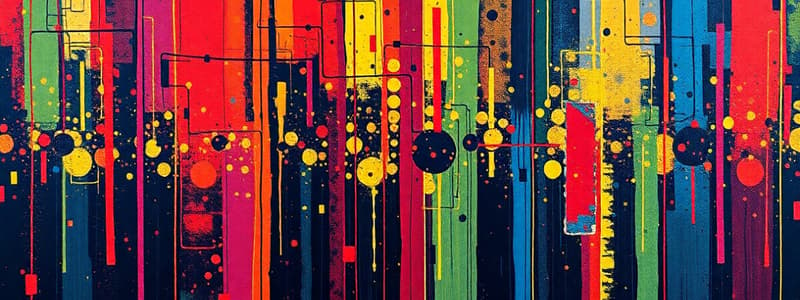Podcast
Questions and Answers
What does a higher Signal-to-Noise Ratio (SNR) indicate about the signal and noise?
What does a higher Signal-to-Noise Ratio (SNR) indicate about the signal and noise?
- The signal is weak and the noise is strong.
- The signal and noise are equal in strength.
- The signal is strong and the noise is weaker. (correct)
- The noise is stronger and the signal is stronger.
Which formula correctly represents the quantity for Signal-to-Noise Ratio in terms of voltage?
Which formula correctly represents the quantity for Signal-to-Noise Ratio in terms of voltage?
- $S/V_s = N/V_n$ (correct)
- $S = V_s / N_v$
- $S/V_s = N/P_n$
- $S/V_n = N/V_s$
If the signal voltage is 4.2 $ ext{μV}$ and the noise voltage is 0.3 $ ext{μV}$, what is the calculated S/N ratio?
If the signal voltage is 4.2 $ ext{μV}$ and the noise voltage is 0.3 $ ext{μV}$, what is the calculated S/N ratio?
- 10
- 14 (correct)
- 1.4
- 12
Why is the S/N ratio typically expressed in terms of power rather than voltage?
Why is the S/N ratio typically expressed in terms of power rather than voltage?
What is indicated if the S/N ratio is low?
What is indicated if the S/N ratio is low?
What is thermal noise also known as?
What is thermal noise also known as?
Which type of noise is associated with semiconductor components like diodes and transistors?
Which type of noise is associated with semiconductor components like diodes and transistors?
What phenomenon occurs due to the random movement of current carriers in a semiconductor?
What phenomenon occurs due to the random movement of current carriers in a semiconductor?
What does flicker noise refer to in semiconductor materials?
What does flicker noise refer to in semiconductor materials?
What is transit-time noise related to?
What is transit-time noise related to?
What type of noise is described as filtered or band-limited noise?
What type of noise is described as filtered or band-limited noise?
What does intermodulation distortion result from?
What does intermodulation distortion result from?
How does noise affect communication systems?
How does noise affect communication systems?
What type of external noise is caused by manufacturing equipment?
What type of external noise is caused by manufacturing equipment?
Which form of atmospheric noise is commonly associated with lightning?
Which form of atmospheric noise is commonly associated with lightning?
What is the primary cause of solar noise?
What is the primary cause of solar noise?
What typically causes internal noise in a receiver?
What typically causes internal noise in a receiver?
What is noise in terms of electronic signals?
What is noise in terms of electronic signals?
How does noise affect digital signals compared to analog signals?
How does noise affect digital signals compared to analog signals?
Which type of noise is affected by a noise cycle from the sun?
Which type of noise is affected by a noise cycle from the sun?
What is a characteristic of cosmic noise?
What is a characteristic of cosmic noise?
What common household example demonstrates noise during radio tuning?
What common household example demonstrates noise during radio tuning?
Which of the following is a common type of internal noise?
Which of the following is a common type of internal noise?
What visual phenomenon identifies noise on a television screen?
What visual phenomenon identifies noise on a television screen?
What happens when noise overshadows the original signal?
What happens when noise overshadows the original signal?
Which type of noise shows the greatest impact on signals with frequencies below 30 𝑀𝐻𝑧?
Which type of noise shows the greatest impact on signals with frequencies below 30 𝑀𝐻𝑧?
What defines the difference between noise and interference?
What defines the difference between noise and interference?
What can high levels of noise lead to in electronic communication?
What can high levels of noise lead to in electronic communication?
What does the term 'signal noise' refer to?
What does the term 'signal noise' refer to?
What is the calculated S/N ratio if the signal power is 6 𝜇𝑊 and the noise power is 120 𝑛𝑊?
What is the calculated S/N ratio if the signal power is 6 𝜇𝑊 and the noise power is 120 𝑛𝑊?
What is the correct formula for converting S/N ratio to decibels (dB) for power?
What is the correct formula for converting S/N ratio to decibels (dB) for power?
What is the result of $10 log(50)$?
What is the result of $10 log(50)$?
Which calculation method is used to express the noise quality of a receiver?
Which calculation method is used to express the noise quality of a receiver?
What is the decibel value for the S/N voltage calculated as $20 log(14)$?
What is the decibel value for the S/N voltage calculated as $20 log(14)$?
Which of the following values represents noise power in the example?
Which of the following values represents noise power in the example?
When calculating the S/N ratio, what is the standard notation for signal power?
When calculating the S/N ratio, what is the standard notation for signal power?
Which of the following correctly represents the S/N ratio formula using example values?
Which of the following correctly represents the S/N ratio formula using example values?
What does the noise factor (NR) represent?
What does the noise factor (NR) represent?
When expressed in decibels, what is the noise factor called?
When expressed in decibels, what is the noise factor called?
Which of the following is NOT a factor that causes distortion?
Which of the following is NOT a factor that causes distortion?
What is a characteristic of distortion in audio transmission?
What is a characteristic of distortion in audio transmission?
How is distortion used in a Dolby system?
How is distortion used in a Dolby system?
How does distortion differ from noise?
How does distortion differ from noise?
Which instrument commonly uses distortion as an effect?
Which instrument commonly uses distortion as an effect?
What is one potential outcome of distortion in audio signal processing?
What is one potential outcome of distortion in audio signal processing?
Flashcards
Noise in Signals
Noise in Signals
Unwanted interference in a signal, degrading its quality, and can affect both analog and digital signals. It's random AC voltage.
Noise Source
Noise Source
The origin of random frequencies and amplitudes affecting a signal, such as electronic devices or other signals.
Signal Interference
Signal Interference
Unwanted signals from other sources that disrupt a signal during transmission or processing.
Analog Signals
Analog Signals
Signup and view all the flashcards
Digital Signals
Digital Signals
Signup and view all the flashcards
Noise Impact on Digital Signals
Noise Impact on Digital Signals
Signup and view all the flashcards
Noise Impact on Analog Signals
Noise Impact on Analog Signals
Signup and view all the flashcards
External Noise
External Noise
Signup and view all the flashcards
Industrial Noise
Industrial Noise
Signup and view all the flashcards
Atmospheric Noise
Atmospheric Noise
Signup and view all the flashcards
Extraterrestrial Noise
Extraterrestrial Noise
Signup and view all the flashcards
Solar Noise
Solar Noise
Signup and view all the flashcards
Cosmic Noise
Cosmic Noise
Signup and view all the flashcards
Internal Noise
Internal Noise
Signup and view all the flashcards
Thermal Noise
Thermal Noise
Signup and view all the flashcards
Semiconductor Noise
Semiconductor Noise
Signup and view all the flashcards
Intermodulation Distortion
Intermodulation Distortion
Signup and view all the flashcards
Thermal Noise
Thermal Noise
Signup and view all the flashcards
White Noise
White Noise
Signup and view all the flashcards
Pink Noise
Pink Noise
Signup and view all the flashcards
Shot Noise
Shot Noise
Signup and view all the flashcards
Transit-Time Noise
Transit-Time Noise
Signup and view all the flashcards
Flicker Noise
Flicker Noise
Signup and view all the flashcards
Intermodulation Distortion
Intermodulation Distortion
Signup and view all the flashcards
Semiconductor Noise
Semiconductor Noise
Signup and view all the flashcards
Signal-to-Noise Ratio (SNR)
Signal-to-Noise Ratio (SNR)
Signup and view all the flashcards
High SNR
High SNR
Signup and view all the flashcards
Low SNR
Low SNR
Signup and view all the flashcards
SNR Formula (voltage)
SNR Formula (voltage)
Signup and view all the flashcards
SNR Formula (power)
SNR Formula (power)
Signup and view all the flashcards
Signal voltage (Vs)
Signal voltage (Vs)
Signup and view all the flashcards
Noise voltage (Vn)
Noise voltage (Vn)
Signup and view all the flashcards
Signal power (Ps)
Signal power (Ps)
Signup and view all the flashcards
Noise power (Pn)
Noise power (Pn)
Signup and view all the flashcards
Signal-to-Noise Ratio (SNR)
Signal-to-Noise Ratio (SNR)
Signup and view all the flashcards
SNR Calculation
SNR Calculation
Signup and view all the flashcards
SNR unit (dB)
SNR unit (dB)
Signup and view all the flashcards
dB calculation for voltage SNR
dB calculation for voltage SNR
Signup and view all the flashcards
dB calculation for power SNR
dB calculation for power SNR
Signup and view all the flashcards
Noise Figure
Noise Figure
Signup and view all the flashcards
Noise Factor
Noise Factor
Signup and view all the flashcards
Noise Factor (NR)
Noise Factor (NR)
Signup and view all the flashcards
Noise Figure (NF)
Noise Figure (NF)
Signup and view all the flashcards
Distortion
Distortion
Signup and view all the flashcards
Distortion vs. Noise
Distortion vs. Noise
Signup and view all the flashcards
Distortion Causes
Distortion Causes
Signup and view all the flashcards
Distortion in Voice Transmission
Distortion in Voice Transmission
Signup and view all the flashcards
Desirable Distortion
Desirable Distortion
Signup and view all the flashcards
Distortion as an Effect
Distortion as an Effect
Signup and view all the flashcards
Study Notes
Noise
- Noise is an electronic signal with random frequencies and amplitudes, added to a signal during transmission or processing.
- It appears as a random AC voltage on an oscilloscope, regardless of the source.
- Noise differs from interference, which disrupts a signal by adding unwanted signals.
- Signal noise degrades analog and digital signals.
- More noise is needed to affect digital signals than analog signals, as digital signals use binary pulses.
Signal-to-Noise Ratio (SNR)
- SNR represents the relative strengths of signal and noise in communication systems.
- High SNR means a strong signal and weak noise; low SNR vice versa.
- Reception is unreliable with low SNR.
- SNR can be expressed in voltage or power using formulas.
- SNR is often expressed in decibels (dB).
Types of Noise
- External Noise: Uncontrollable noise sources like industrial, atmospheric, or extraterrestrial.
- Industrial Noise: From manufacturing equipment (e.g., generators, motors).
- Atmospheric Noise: Electrical disturbances, often from lightning (static).
- Extraterrestrial Noise: From the sun (solar noise), with an 11-year cycle of increased intensity.
Internal Noise
- Noise from components within a receiver (resistors, diodes, transistors).
- Thermal Noise (White Noise): Random motion of electrons due to heat.
- Semiconductor Noise: From diodes and transistors, including shot noise, transit-time noise, and flicker noise.
- Intermodulation Distortion: From generating new signals and harmonics due to circuit nonlinearities.
Distortion
- Distortion is an unwanted change in an information signal (audio/video).
- Distortion affects signal waveform in electronic devices and communication channels.
- Causes include environmental factors, channel properties, and transmission distance.
- Some distortions are desirable, like in noise reduction systems or musical effects (e.g., electric guitar).
Studying That Suits You
Use AI to generate personalized quizzes and flashcards to suit your learning preferences.




